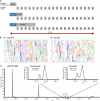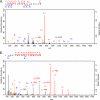Ultra high resolution linear ion trap Orbitrap mass spectrometer (Orbitrap Elite) facilitates top down LC MS/MS and versatile peptide fragmentation modes
- PMID: 22159718
- PMCID: PMC3316736
- DOI: 10.1074/mcp.O111.013698
Ultra high resolution linear ion trap Orbitrap mass spectrometer (Orbitrap Elite) facilitates top down LC MS/MS and versatile peptide fragmentation modes
Abstract
Although only a few years old, the combination of a linear ion trap with an Orbitrap analyzer has become one of the standard mass spectrometers to characterize proteins and proteomes. Here we describe a novel version of this instrument family, the Orbitrap Elite, which is improved in three main areas. The ion transfer optics has an ion path that blocks the line of sight to achieve more robust operation. The tandem MS acquisition speed of the dual cell linear ion trap now exceeds 12 Hz. Most importantly, the resolving power of the Orbitrap analyzer has been increased twofold for the same transient length by employing a compact, high-field Orbitrap analyzer that almost doubles the observed frequencies. An enhanced Fourier Transform algorithm-incorporating phase information-further doubles the resolving power to 240,000 at m/z 400 for a 768 ms transient. For top-down experiments, we combine a survey scan with a selected ion monitoring scan of the charge state of the protein to be fragmented and with several HCD microscans. Despite the 120,000 resolving power for SIM and HCD scans, the total cycle time is within several seconds and therefore suitable for liquid chromatography tandem MS. For bottom-up proteomics, we combined survey scans at 240,000 resolving power with data-dependent collision-induced dissociation of the 20 most abundant precursors in a total cycle time of 2.5 s-increasing protein identifications in complex mixtures by about 30%. The speed of the Orbitrap Elite furthermore allows scan modes in which complementary dissociation mechanisms are routinely obtained of all fragmented peptides.
Figures






Similar articles
-
Mass spectrometry-based proteomics using Q Exactive, a high-performance benchtop quadrupole Orbitrap mass spectrometer.Mol Cell Proteomics. 2011 Sep;10(9):M111.011015. doi: 10.1074/mcp.M111.011015. Epub 2011 Jun 3. Mol Cell Proteomics. 2011. PMID: 21642640 Free PMC article.
-
Evaluation and optimization of mass spectrometric settings during data-dependent acquisition mode: focus on LTQ-Orbitrap mass analyzers.J Proteome Res. 2013 Jul 5;12(7):3071-86. doi: 10.1021/pr3011588. Epub 2013 May 31. J Proteome Res. 2013. PMID: 23642296 Free PMC article.
-
Characterization of a high field Orbitrap mass spectrometer for proteome analysis.Proteomics. 2013 Sep;13(17):2552-62. doi: 10.1002/pmic.201300076. Epub 2013 Jul 30. Proteomics. 2013. PMID: 23836775
-
Screening of synthetic PDE-5 inhibitors and their analogues as adulterants: analytical techniques and challenges.J Pharm Biomed Anal. 2014 Jan;87:176-90. doi: 10.1016/j.jpba.2013.04.037. Epub 2013 May 6. J Pharm Biomed Anal. 2014. PMID: 23721687 Review.
-
Multiplexed and data-independent tandem mass spectrometry for global proteome profiling.Mass Spectrom Rev. 2014 Nov-Dec;33(6):452-70. doi: 10.1002/mas.21400. Epub 2013 Nov 26. Mass Spectrom Rev. 2014. PMID: 24281846 Review.
Cited by
-
The Negative Mode Proteome with Activated Ion Negative Electron Transfer Dissociation (AI-NETD).Mol Cell Proteomics. 2015 Oct;14(10):2644-60. doi: 10.1074/mcp.M115.049726. Epub 2015 Jul 20. Mol Cell Proteomics. 2015. PMID: 26193884 Free PMC article.
-
Mass Spectrometry Targeted Assays as a Tool to Improve Our Understanding of Post-translational Modifications in Pathogenic Bacteria.Front Microbiol. 2016 Aug 4;7:1216. doi: 10.3389/fmicb.2016.01216. eCollection 2016. Front Microbiol. 2016. PMID: 27540373 Free PMC article. No abstract available.
-
Automated gas-phase purification for accurate, multiplexed quantification on a stand-alone ion-trap mass spectrometer.Anal Chem. 2013 Feb 19;85(4):2079-86. doi: 10.1021/ac302156t. Epub 2012 Oct 24. Anal Chem. 2013. PMID: 23046161 Free PMC article.
-
Taspase1 Facilitates Topoisomerase IIβ-Mediated DNA Double-Strand Breaks Driving Estrogen-Induced Transcription.Cells. 2023 Jan 18;12(3):363. doi: 10.3390/cells12030363. Cells. 2023. PMID: 36766705 Free PMC article.
-
Structural Analysis of Hippocampal Kinase Signal Transduction.ACS Chem Neurosci. 2018 Dec 19;9(12):3072-3085. doi: 10.1021/acschemneuro.8b00284. Epub 2018 Aug 13. ACS Chem Neurosci. 2018. PMID: 30053369 Free PMC article.
References
-
- Kaiser N. K., Savory J. J., McKenna A. M., Quinn J. P., Hendrickson C. L., Marshall A. G. (2011) Electrically compensated fourier transform ion cyclotron resonance cell for complex mixture mass analysis. Anal. Chem. 83, 6907–6910 - PubMed
-
- Makarov A. (2000) Electrostatic axially harmonic orbital trapping: a high-performance technique of mass analysis. Anal. Chem. 72, 1156–1162 - PubMed
-
- Scigelova M., Makarov A. (2006) Orbitrap mass analyzer—overview and applications in proteomics. Proteomics 6 Suppl 2, 16–21 - PubMed
-
- Makarov A., Denisov E., Kholomeev A., Balschun W., Lange O., Strupat K., Horning S. (2006) Performance evaluation of a hybrid linear ion trap/orbitrap mass spectrometer. Anal. Chem. 78, 2113–2120 - PubMed
Publication types
MeSH terms
Substances
LinkOut - more resources
Full Text Sources
Other Literature Sources
Molecular Biology Databases

